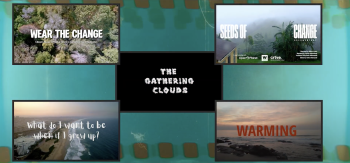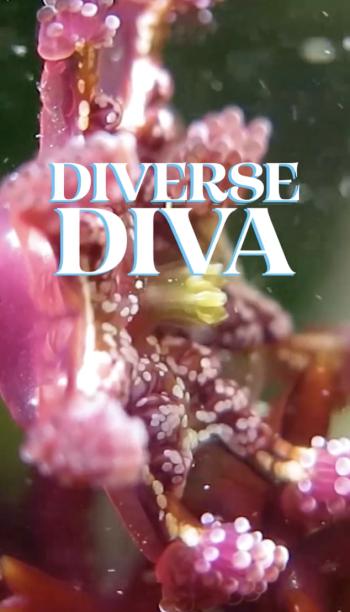Interview: How data science can elevate storytelling
The role of credible, trusted data in visual storytelling has never been more critical. Hear from Gabriel O’Donnell, Principal Programmer for EarthTime at Carnegie Mellon University, on how data-driven stories can elevate public understanding of environmental challenges.
As the world grapples with the complexities of the planetary crisis, the power of well-crafted visuals, bolstered by accurate data, can be a pivotal tool in engaging and educating audiences. This concept inspired the creation of Open Planet, equipping storytellers with world-class footage and science to create impactful visual content.
The compelling data visualisations available through the Open Planet library are produced by its co-founder, Carnegie Mellon University’s CREATE Lab – creators of interactive, data-driven stories using the EarthTime platform. Their team of data scientists combine huge data sets with satellite imagery to help document changes to our planet over time, while also forecasting future trends.
This data visualisation clip by EarthTime shows deforestation caused by road construction in the Rondônia province of Brazil. Available here.
How can data visualisations help to enhance the narrative of a story and deliver impact?
“Film preserves the present. Watching a clip transports us and centres us in the action. We are with the polar bear swimming across an impossible expanse of open sea. We are in the forest engulfed by fire.
Data visualisation offers context that transcends the now. The ice that the polar bear expected to walk across? It has been receding and thinning at rates now visible through colour coded ranges annually presented over the decades. The fire’s path becomes intentional and specific as it repeats seasonally across the same rough geographic area until the forest becomes serviceable for cattle ranching.
In data we also find the power to make the need for action undeniable. We move audiences from questioning reality towards acting to make a better future for our planet.“
"Data visualisation offers context that transcends the now. In data we also find the power to make the need for action undeniable."
— Gabriel O’Donnell, Principal Programmer for EarthTime at Carnegie Mellon University
How can big data be used in storytelling both to demonstrate changes to our planet and the solutions to help reimagine our future?
“We understand change at the small and immediate. A shop down the street opens. An off-ramp from a highway is expanded. The past feels remote and immutable. We presume our seasonal weather has always been the way that it is. That across decades our winters, springs, summers and autumns have been exact and unchanging.
Data of sufficient scope and size can transform this point-of-view. The city is no longer a constant fixture of delineated neighbourhoods and established conveyance routes. Viewed from decades of satellite imagery, it expands as a living thing.
A century of climate data, colour coded and played back in seasonal succession, reveals that our seasons are incrementally hotter. That the weather patterns we think of as fixed and synonymous with climate are in fact flexing to accommodate a future that we cannot yet see but are beginning to sense.”
This data visualisation clip created by EarthTime shows fluctuations in global temperature anomalies over time. Available here.
How do you approach making complex scientific information accessible and engaging to a broad audience?
“We look for the confluence of art and maths to inform our process. Colours, frame transitions and speed of playback are chosen with intention to illustrate key trends and information. We approach this work with a pace that relies more on deliberation than inspiration. The mechanics of building the visualisations owe more to craft than to creative expression.
By combining computational technology and visual artistry, we can turn complex, multi-dimensional data into accessible content that people can use in their own stories to make sense of our changing world.”
What role can storytelling and innovation play in helping to combat the rise of misinformation and disinformation?
“In the present, facts and reality feel up for debate. Bad actors, unreliable narrators and intentional malfeasance makes it hard to trust what we see and read online. Transparency is the antidote to this atmosphere.
It is crucial that the data used in our visualisations come from trusted sources that are open and clear as to the gathering and construction of their data. Our design, our plan, is to make the process of our visualisations as equally transparent and understandable.
By open-sourcing this data, making it freely available in compelling visual clips, storytellers everywhere can confidently communicate about the realities of our world and spread validated information that moves people to action.”
“In the present, facts and reality feel up for debate. Transparency is the antidote to this atmosphere."
— Gabriel O’Donnell, Principal Programmer for EarthTime at Carnegie Mellon University
What data-driven stories can we expect to find on Open Planet?
“We use EarthTime to tell a variety of data stories. All of the data visualisations on Open Planet are connected to global climate and population issues in some way. Individually they focus on different topics and geographic areas, from forest loss in the Amazon to the impact of projected sea level rise in southeast Asia. Our goal is to build content that is diverse and wide ranging for Open Planet’s users and other partners.”
Start your story
Discover our growing collection of data visualisations, created using the EarthTime platform, to help tell the story of our changing planet.
Browse the library
Beyond the videos available in our content library, the EarthTime platform has hundreds of data layers, all available to explore at www.earthtime.org.





